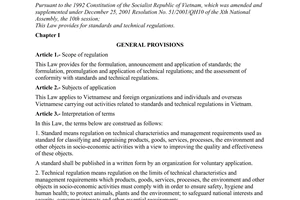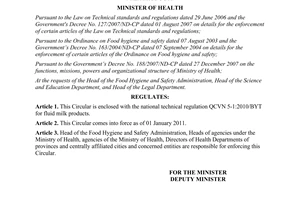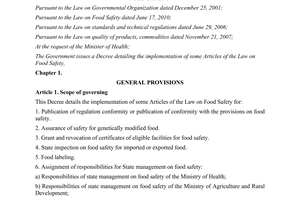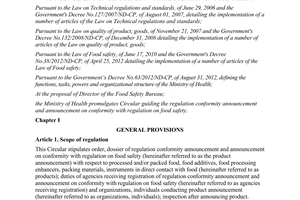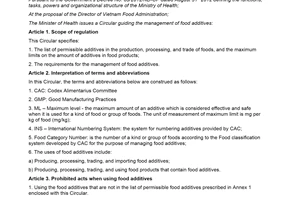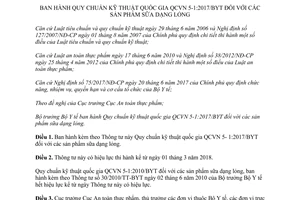Nội dung toàn văn Circular 03/2017/TT-BYT QCVN 5-1:2017/BYT National technical regulation for fluid milk product
|
MINISTRY OF
HEALTH |
THE
SOCIALIST REPUBLIC OF VIETNAM |
|
No. 03/2017/TT-BYT |
Hanoi, March 22, 2017 |
CIRCULAR
QCVN 5-1:2017/BYT - NATIONAL TECHNICAL REGULATION FOR FLUID MILK PRODUCT
Pursuant to the Law on Technical Standards and Regulation dated June 29, 2006 and the Government’s Decree No. 127/2007/ND-CP dated August 01, 2007 elaborating the implementation of some articles of the Law on Technical Standards and Regulation;
Pursuant to the Law on Food Safety dated June 17, 2010 and the Government’s Decree No. 38/2012/ND-CP dated April 25, 2012 elaborating the implementation of some articles of the Law on Food Safety;
Pursuant to the Government’s Decree No. 75/2017/ND-CP dated June 20, 2017 defining functions, tasks, powers and organizational structure of the Ministry of National Defense;
At the request of the Director General of Vietnam Food Administration;
The Minister of Health promulgates QCVN 5-1:2017/BYT - National technical regulation for fluid milk product.
Article 1. QCVN 5-1:2017/BYT - National technical regulation for fluid milk product is promulgated together with this Circular.
Article 2. This Circular comes into force from March 01, 2018
QCVN 5-1:2010/BYT - National technical regulation for fluid milk product promulgated together with the Circular No. 30/2010/TT-BYT dated June 02, 1010 of the Minister of Health expires from the effective date of this Circular.
Article 3. The Director General of Vietnam Food Administration, heads of units affiliated to the Ministry of Health, units affiliated to the Ministry of Health; Directors of Departments of Health of provinces and central-affiliated cities and relevant authorities, organizations and individuals are responsible for implementing this Circular./.
|
|
PP. MINISTER |
QCVN 5-1:2017/BYT
NATIONAL TECHNICAL REGULATION FOR FLUID MILK PRODUCTS
Foreword
QCVN 5-1:2017/BYT is drafted by the Drafting Committee for national technical regulation for fluid milk products, submitted by the Vietnam Food Administration for approval and is promulgated together with the Circular No. 03/2017/TT-BYT dated March 22, 2017 of the Minister of Health.
NATIONAL TECHNICAL REGULATION FOR FLUID MILK PRODUCTS
I. GENERAL PROVISIONS
1. Scope
This Regulation provides for the safety limits and management requirements for fluid milk products, including fresh milk (pasteurized/sterilized fresh whole milk, pasteurized/sterilized fresh skimmed whole milk, pasteurized/sterilized fresh milk, pasteurized/sterilized fresh skimmed milk), pasteurized/sterilized reconstituted milk, pasteurized/sterilized composite milk, condensed milk and sweetened condensed milk (condensed milk, sweetened condensed milk, a blend of evaporated skimmed milk and vegetable fat, a blend of sweetened condensed skimmed milk and vegetable fat).
This Regulation shall not apply to formula milk products for young children aged 36 months or below and formula milk for special medical purposes for infants, and functional food.
2. Regulated entities
This Regulation shall apply to producers, sellers and importers of fluid milk products in Vietnam and relevant organizations and individuals.
3. Rules for formulation
This Regulation is formulated according to the following rules:
3.1. The safety of consumers' health is ensured.
3.2. Condition of production, trading and import in Vietnam is conformed to.
3.3. National standards and regulations of Vietnam law are conformed to.
3.4. International standards and regulations are conformed to avoid creating barriers to trade exchange between Vietnam and other countries in the world.
3.5. Risk management recommendations from domestic and foreign competent authorities, Food and Agriculture Organization (FAO), World Health Organization (WHO) and Codex Alimentarius Commission (CODEX) are updated.
4. Definitions
For the purposes of this Regulation, the terms below are construed as follows:
4.1 “raw fresh milk” is fluid milk that is obtained from cows, buffaloes, goats and sheep without either addition to it or extraction from it is not processed by any method and used as an ingredient for processing.
4.2. “milk product” is a product obtained by any processing of milk, which may contain food additives, and other necessary ingredients functionally necessary for the processing.
4.3. “powdered milk” is a powdered product resulting from the removal of water from raw fresh milk. The fat and/or protein content of the milk may have been adjusted by the addition and/or removal of milk constituents in such a way as not to alter the whey protein to casein ratio of the milk being adjusted.
4.4. “milk fat” is the fat that is derived from milk or milk products and processed by a method that can remove most of the water and milk solids-non-fat.
4.5. “milk solids-non-fat” is a product resulting from removal of water and milk fat from raw fresh milk.
4.6. Fresh milk
4.6.1. “pasteurized/sterilized fresh whole milk” is a product that is completely prepared from raw fresh milk without the addition or removal of any milk constituents and without the addition of any other constituent, and that has undergone pasteurization/sterilization.
4.6.2. “pasteurized/sterilized fresh skimmed whole milk” is a product that is completely prepared from raw fresh milk, separated from milk fat without the addition or removal of any other milk constituent and without the addition of any other constituent, and that has undergone pasteurization/sterilization.
4.6.3. “pasteurized/sterilized fresh milk” is a product that is mainly prepared from raw fresh milk (raw fresh milk accounts for at least 90% calculated according to the volume of the final product)
This product may be added with other constituents without substituting the main constituents and has undergone pasteurization/sterilization.
4.6.4. “pasteurized/sterilized fresh skimmed milk” is a product that is mainly prepared from raw fresh milk separated from milk fat (raw fresh milk separated from milk fat accounts for at least 90% calculated according to the volume of the final product).
This product may be added with other constituents without substituting the main constituents and has undergone pasteurization/sterilization.
4.7. “pasteurized/sterilized reconstituted milk” is the fluid that is obtained by adding water to powdered milk or condensed milk in the amount necessary to re-establish the appropriate water solids ratio or is obtained by mixing milk fat and milk solids-non-fat with or without the addition of water to achieve the appropriate milk product composition.
This product may be added with other constituents without substituting the main constituents and has undergone pasteurization/sterilization. The constituents of reconstituted milk account for at least 90% calculated according to the volume of the final product.
4.8. “pasteurized/sterilized composite milk” is a product that is prepared from the combination of raw fresh milk, milk products or milk constituents.
This product may be added with other constituents without substituting the main constituents and has undergone pasteurization/sterilization. The constituents of composite milk account for at least 90% calculated according to the volume of the final product.
4.9. Condensed milk and sweetened condensed milk
4.9.1. “condensed milk” is a product that is obtained by the partial removal of water from raw fresh milk by heat, or by any other process. The fat and/or protein content of the milk may have been adjusted by the addition and/or removal of milk constituents in such a way as not to alter the whey protein to casein ratio of the milk being adjusted.
This product may be added with other constituents without substituting the main constituents.
4.9.2. “sweetened condensed milk” is a product that is obtained by the partial removal of water from raw fresh milk or addition of water to powdered milk, with the addition of sugar. The fat and/or protein content of the milk may have been adjusted by the addition and/or removal of milk constituents in such a way as not to alter the whey protein to casein ratio of the milk being adjusted.
This product may be added with other constituents without substituting the main constituents.
4.9.3. “a blend of evaporated skimmed milk and vegetable fat” is a product that is prepared by recombining skimmed milk and potable water, or by the partial removal of water, with the addition of vegetable fat.
This product may be added with other constituents without substituting the main constituents.
4.9.4. “a blend of condensed skimmed milk and vegetable fat” is a product that is prepared by recombining skimmed milk and potable water, or by the partial removal of water, with the addition of sugar and vegetable fat.
This product may be added with other constituents without substituting the main constituents.
II. TECHINCAL REQUIREMENTS
5. Requirements for raw fresh milk for production of fluid milk products
The raw fresh milk used for production of fluid milk products must satisfy quality and food safety requirements according to regulations of the Minister of Agriculture and Rural Development.
6. Physical and chemical and safety criteria for fluid milk products
6.1. Physical and chemical criteria are specified in Appendix I of this Regulation.
6.2. Maximum limits of pollutants are specified in Appendix II of this Regulation.
6.3. Maximum limits of microbial contamination are specified in Appendix II of this Regulation.
6.4. Food additives permitted for use in fluid milk products comply with regulations of the Circular No. 27/2012/TT-BYT dated November 30, 2012 of the Minister of Health providing guidance on the management of food additives and the Circular No. 08/2015/TT-BYT dated May 11, 2015 of the Minister of Health on amendments to some regulations of the Circular No. 27/2012/TT-BYT dated November 30, 2012 of the Minister of Health providing guidance on the management of food additives.
6.5. Test methods are specified in the Appendix IV of this Regulation.
6.6. In the cases where test methods are yet to be specified in this Regulation, the Ministry of Health shall decide the test methods according to applicable domestic and foreign methods.
7. Labeling
7.1. The labeling of fluid milk products shall comply with regulations set forth in the Government’s Decree No. 43/2017/ND-CP dated April 14, 2017 on goods labels, and other relevant legislative documents.
7.2. The characteristics of the product must be specified on the front side of the product package in accordance with this Regulation.
III. MANAGEMENT REQUIREMENTS
8. Declaration of Conformity
8.1. Declarations of conformity of imported and domestic fluid milk products must be submitted in accordance with regulations of this document.
8.2. Methods and procedures for submission of declarations of conformity shall comply with the Government’s Decree No. 38/2012/ND-CP dated April 25, 2012 elaborating the implementation of some articles of the Law on Food Safety, the Circular No. 19/2012/TT-BYT dated September 11, 2012 of the Minister of Health providing guidance on submission of declarations of conformity and conformity with regulation on food safety and other relevant regulations.
9. Transition clause
9.1. Certificate of submission of Declaration of Conformity
The fluid milk product that has been issued with a Certificate of submission of Declaration of Conformity according to the national technical regulation QCVN 5-1:2010/BYT for fluid milk products shall continue to use this Certificate for production, import and trading until the expiry date of the Certificate.
9.2. Product labels and commercial containers attached to the product labels
9.2.1. The fluid milk product that has been labeled in accordance with the national technical regulation QCVN 5-1:2010/BYT for fluid milk products and produced, imported, sold and used before the effective date of this Regulation shall continue to be sold and used until the expiry date specified in such product label.
9.2.2. The product labels and commercial containers attached to product labels in accordance with the national technical regulation QCVN 5-1:2010/BYT for fluid milk products that have been produced and printed before the effective date of this Regulation shall continue to be used not exceeding 06 months from the effective date of this Regulation.
9.2.3. Producers and importers of fluid milk products are responsible for declaring the number of products labeled in accordance with regulations of law before March 01, 2018 and informing the Ministry of Health (Vietnam Food Administration) thereof.
V. IMPLEMENTATION
10. Vietnam Food Administration shall take charge and cooperate with relevant authorities in providing guidance and organizing the implementation of this Regulation.
11. Based on the management requirements, Vietnam Food Administration is responsible for requesting the Ministry of Health to make amendments to this Regulation.
12. In the cases where the regulations on test methods in accordance with the national standard and legislative documents referred to in this Regulation are amended or replaced, the regulations on new test methods and documents shall apply.
APPENDIX I
PHYSICAL AND CHEMICAL CRITERIA
|
Criteria |
Specified limit |
Test methods |
|
I. Fresh milk |
|
|
|
1. Milk protein content, not less than |
2.7 % |
TCVN
8099-5:2009 |
|
2. Density at 20°C, not less than |
1.026 |
TCVN
5860:2007 |
|
II. Reconstituted milk and composite milk |
||
|
1. Milk protein content, not less than |
2.7 % |
TCVN
8099-5:2009 |
|
III. Condensed milk and sweetened condensed milk |
||
|
1. Milk protein content in milk solids-non-fat, not less than |
34 % |
TCVN
8099-5:2009 |
APPENDIX II
MAXIMUM LIMITS OF POLLUTANTS
|
Critieria |
Allowable maximum limit |
Test methods |
|
I. Heavy metals |
||
|
1. Lead, mg/kg for the products specified in Clauses 4.6 to 4.8, or mg/kg of the finished product for immediate for the products specified in Clause 4.9. |
0.02 |
TCVN
7933:2009 |
|
2. Tin (for products in tin-coated packaging), mg/kg |
250 |
TCVN
7730:2007 |
|
II. Mycotoxins |
||
|
1. Aflatoxin M1, µg/kg |
0.5 |
TCVN
6685:2009 |
|
III. Melamine, mg/kg |
||
|
1. Melamine1), mg/kg |
2.5 |
TCVN
9048:2012 |
|
1) Melamine content is not mandatory for conformity assessment but producers, importers and processors of fluid milk products must not exceed the aforementioned maximum limits. |
||
APPENDIX III
MAXIMUM LIMITS OF MICROBIAL CONTAMINATION
|
Critieria |
Allowable maximum limit |
Test methods |
|
|
n 2) |
M 3) |
||
|
1. Enterobacteriaceae (only applied to pasteurized fluid milk products) |
5 |
10 CFU/ml |
TCVN
5518-2:2007 |
|
2. L. monocytogenes |
5 |
100 CFU/ml |
TCVN
7700-2:2007 |
|
2) n: The number of samples taken from the batch/shipment to be inspected. 3) M: The maximum limit. |
|||
APPENDIX IV
LIST OF TEST METHODS
I. Sampling
1. TCVN 6400 (ISO 707) Milk and milk products - Guidance on sampling.
II. Methods of testing physical and chemical criteria
2. TCVN 5860:2007 Pasteurized fresh milk
3. TCVN 7028:2009 Sterilized fresh milk
4. TCVN 8099-1:2015 (ISO 8968-1:2014) Milk - Determination of nitrogen content - Part 1: Kjeldahl method
5. TCVN 8099-5:2009 (ISO 8968-5:2001) Milk - Determination of nitrogen content - Part 5: Kjeldahl method
III. Methods of testing pollutants
III.1. Heavy metals
6. TCVN 7933:2009 (ISO/TS 6733:2006) Milk and milk products - Determination of lead content - Graphite furnace atomic absorption spectrometric method
7. TCVN 7929:2008 (EN 14083:2003) Foodstuffs - Determination of trace elements - Determination of lead, cadmium, chromium and molybdenum by graphite furnace atomic absorption spectrometry (GFAAS) after pressure digestion
8. TCVN 10912:2015 (EN 15763:2009) Foodstuffs - Determination of trace elements - Determination of arsenic, cadmium, mercury and lead in foodstuffs by inductively coupled plasma mass spectrometry (ICP-MS) after pressure digestion
9. TCVN 7730:2007 (ISO/TS 9941:2005) Milk and canned evaporated milk - Determination of tin content - Spectrometric method
10. TCVN 7788:2007 Canned foods - Determination of tin content by atomic absorption spectrophotometric method
11. TCVN 10913:2015 (EN 15764:2009) Foodstuffs - Determination of trace elements - Determination of tin by flame and graphite furnace atomic absorption spectrometry (FAAS and GFAAS) after pressure digestion
12. TCVN 10914:2015 (EN 15765:2009) Foodstuffs - Determination of trace elements - Determination of tin by inductively coupled plasma mass spectrometry (ICP-MS) after pressure digestion
13. TCVN 10643:2014 Foodstuffs - Determination of lead, cadmium, copper, iron, and zinc - Atomic absorption spectrophotometric method after dry ashing
14. TCVN 8110:2009 (ISO 14377:2002) Canned evaporated milk - Determination of tin content - Method using graphite furnace atomic absorption spectrometry
III.2. Mycotoxins
15. TCVN 6685:2009 (ISO 14501:2007) Milk and milk powder – Determination fo aflatoxin M1 content – Clean-up by immunoaffinity chromatography and determination by high-performance liquid chromatography
III.3. Melamine
16. TCVN 9048:2012 (ISO/TS 15495:2010) Milk, milk products and infant formulae - Guidelines for the quantitative determination of melamine and cyanuric acid by liquid chromatography - tandem mass spectrometry (LC-MS/MS)
IV. Methods of testing microbiological criteria
17. TCVN 5518-2:2007 (ISO 21528-2:2004) Microbiology of food and animal feeding stuffs - Horizontal methods for the detection and enumeration of Enterobacteriaceae - Part 2: Colony-count method
18. TCVN 9980:2013 Microbiology of food and animal feeding stuffs – Enumeration of Enterobacteriaceae using Petrifilm™ count plate
19. TCVN 7700-2:2007 (ISO 11290-2:1998, With amd.1:2004) Microbiology of food and animal feeding stuffs - Horizontal method for the detection and enumeration of Listeria monocytogenes - Part 2: Enumeration method
(Other test methods with equivalent accuracy may be used.)
------------------------------------------------------------------------------------------------------
This translation is made by LawSoft and
for reference purposes only. Its copyright is owned by LawSoft
and protected under Clause 2, Article 14 of the Law on Intellectual Property.Your comments are always welcomed
